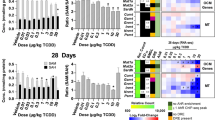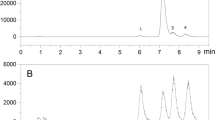Abstract
Methylmercury (MeHg) and 2,3,7,8-tetrachlorodibenzodioxin (TCDD) are potent environmental pollutants implicated in the modulation of xenobiotic-metabolizing enzymes, particularly the cytochrome P450 1 family (CYP1) which is regulated by the aryl hydrocarbon receptor (AHR). However, the co-exposure to MeHg and TCDD raises concerns about their potential combined effects, necessitating thorough investigation. The primary objective of this study was to investigate the individual and combined effects of MeHg and TCDD on AHR-regulated CYP1 enzymes in mouse extrahepatic tissues. Therefore, C57BL/6 mice were administrated with MeHg (2.5 mg/kg) in the absence and presence of TCDD (15 μg/kg) for 6 and 24 h. The AHR-regulated CYP1 mRNA and protein expression levels were measured in the heart, lung, and kidney, using RT real-time PCR and western blot, respectively. Interestingly, treatment with MeHg exhibited mainly inhibitory effect, particularly, it decreased the basal level of Cyp1a1 and Cyp1a2 mRNA and protein, and that was more evident at the 24 h time point in kidney followed by heart. Similarly, when mice were co-exposed, MeHg was able to reduce the TCDD-induced Cyp1a1 and Cyp1a2 expression, however, MeHg potentiated kidney Cyp1b1 mRNA expression, opposing the observed change on its protein level. Also, MeHg induced antioxidant NAD(P)H:quinone oxidoreductase (NQO1) mRNA and protein in kidney, while heme-oxygenase (HO-1) mRNA was up-regulated in heart and kidney. In conclusion, this study reveals intricate interplay between MeHg and TCDD on AHR-regulated CYP1 enzymes, with interesting inhibitory effects observed that might be significant for procarcinogen metabolism. Varied responses across tissues highlight the potential implications for environmental health.







Similar content being viewed by others
Data Availability
The data supporting the findings of this study will be made available upon reasonable request from the corresponding author.
Abbreviations
- AHR:
-
Aryl hydrocarbon receptor
- Hg:
-
Mercury
- MeHg:
-
Methylmercury
- Nrf2:
-
Nuclear factor-erythroid factor 2-related factor 2
- NQO1:
-
NADP(H):quinone oxidoreductase
- TCDD:
-
2,3,7,8-Tetrachlorodibenzo-p-dioxin
- XRE:
-
Xenobiotic-response element
References
Ullrich SM, Tanton TW, Abdrashitova SA (2001) Mercury in the aquatic environment: a review of factors affecting methylation. Crit Rev Environ Sci Technol 31(3):241–293
Razavi NR, Qu M, Jin B, Ren W, Wang Y, Campbell LM (2014) Mercury biomagnification in subtropical reservoir fishes of eastern China. Ecotoxicology 23:133–146
Ackerman JT, Eagles-Smith CA, Herzog MP (2011) Bird mercury concentrations change rapidly as chicks age: toxicological risk is highest at hatching and fledging. Environ Sci Technol 45(12):5418–5425
Stern AH, Smith AE (2003) An assessment of the cord blood: maternal blood methylmercury ratio: implications for risk assessment. Environ Health Perspect 111(12):1465–1470
Harada M (1995) Minamata disease: methylmercury poisoning in Japan caused by environmental pollution. Crit Rev Toxicol 25(1):1–24
Fiedler H, Hutzinger O, Timms CW (1990) Dioxins: sources of environmental load and human exposure. Toxicol Environ Chem 29(3):157–234
Boverhof DR et al (2006) Comparative toxicogenomic analysis of the hepatotoxic effects of TCDD in Sprague Dawley rats and C57BL/6 mice. Toxicol Sci 94(2):398–416
Boverhof DR et al (2005) Temporal and dose-dependent hepatic gene expression patterns in mice provide new insights into TCDD-mediated hepatotoxicity. Toxicol Sci 85(2):1048–1063
Amara IEA, Anwar-Mohamed A, El-Kadi AOS (2013) Posttranslational mechanisms modulating the expression of the cytochrome P450 1A1 gene by methylmercury in HepG2 cells: a role of heme oxygenase-1. Toxicol Lett 219(3):239–247
Alqahtani MA, El-Ghiaty MA, El-Mahrouk SR, El-Kadi AOS (2023) Methylmercury (MeHg) transcriptionally regulates NAD(P)H:quinone oxidoreductase 1 (NQO1) in Hepa-1c1c7 cells. Current research in toxicology 5:100126. https://doi.org/10.1016/j.crtox.2023.100126
Alqahtani MA, El-Ghiaty MA, El-Kadi AOS (2023) Mercury and methylmercury differentially modulate hepatic cytochrome P450 1A1 and 1A2 in vivo and in vitro. J Biochem Mol Toxicol 37(2):e23243
Nebert DW, Karp CL (2008) Endogenous functions of the aryl hydrocarbon receptor (AHR): intersection of cytochrome P450 1 (CYP1)-metabolized eicosanoids and AHR biology. J Biol Chem 283(52):36061–36065
Walker NJ et al (1999) Characterization of the dose–response of CYP1B1, CYP1A1, and CYP1A2 in the liver of female Sprague-Dawley rats following chronic exposure to 2, 3, 7, 8-tetrachlorodibenzo-p-dioxin. Toxicol Appl Pharmacol 154(3):279–286
Go R-E, Hwang K-A, Choi K-C (2015) Cytochrome P450 1 family and cancers. J Steroid Biochem Mol Biol 147:24–30
Nebert DW, Dalton TP (2006) The role of cytochrome P450 enzymes in endogenous signalling pathways and environmental carcinogenesis. Nat Rev Cancer 6(12):947–960
Rifkind AB (2006) CYP1A in TCDD toxicity and in physiology–with particular reference to CYP dependent arachidonic acid metabolism and other endogenous substrates. Drug Metab Rev 38(1–2):291–335
Wang H, Chen B, He M, Yu X, Hu B (2017) Selenocystine against methyl mercury cytotoxicity in HepG2 cells. Sci Rep 7(1):147
Wang W, Clarkson TW, Ballatori N (2000) γ-Glutamyl transpeptidase and L-cysteine regulate methylmercury uptake by HepG2 cells, a human hepatoma cell line. Toxicol Appl Pharmacol 168(1):72–78
Robinson JF, Griffith WC, Yu X, Hong S, Kim E, Faustman EM (2010) Methylmercury induced toxicogenomic response in C57 and SWV mouse embryos undergoing neural tube closure. Reprod Toxicol 30(2):284–291
El-Ghiaty MA, Alqahtani MA, El-Kadi AOS (2022) Down-regulation of hepatic cytochromes P450 1A1 and 1A2 by arsenic trioxide (ATO) in vivo and in vitro: a role of heme oxygenase 1. Chem Biol Interact 364:110049
El-Ghiaty MA, Alqahtani MA, El-Kadi AOS (2023) Modulation of cytochrome P450 1A (CYP1A) enzymes by monomethylmonothioarsonic acid (MMMTAV) in vivo and in vitro. Chem Biol Interact 376:110447. https://doi.org/10.1016/j.cbi.2023.110447
Lowry OH, Rosebrough NJ, Farr AL, Randall RJ (1951) Protein measurement with the Folin phenol reagent. J Biol Chem 193:265–275
Wong PS, Vogel CF, Kokosinski K, Matsumura F (2010) Arylhydrocarbon receptor activation in NCI-H441 cells and C57BL/6 mice: possible mechanisms for lung dysfunction. Am J Respir Cell Mol Biol 42(2):210–217
Hu H, Möller G, Abedi-Valugerdi M (1999) Mechanism of mercury-induced autoimmunity: both T helper 1-and T helper 2-type responses are involved. Immunology 96(3):348
Maqbool F et al (2019) Biochemical evidence on the potential role of methyl mercury in hepatic glucose metabolism through inflammatory signaling and free radical pathways. J Cell Biochem 120(9):16195–16205
Díaz D, Krejsa CM, White CC, Keener CL, Farin FM, Kavanagh TJ (2001) Tissue specific changes in the expression of glutamate–cysteine ligase mRNAs in mice exposed to methylmercury. Toxicol Lett 122(2):119–129
Chang LW, Magos L, Suzuki T (1996) Toxicology of metals. CRC, Boca Raton
Mehra M, Kanwar KC (1980) Biochemical changes resulting from the intraperitoneal administration of mercuric chloride and methylmercuric chloride to mice. Toxicol Lett 6(4–5):319–326
Omata S, Sato M, Sakimura K, Sugano H (1980) Time-dependent accumulation of inorganic mercury in subcellular fractions of kidney, liver, and brain of rats exposed to methylmercury. Arch Toxicol 44:231–241
Norseth T, Clarkson TW (1970) Biotransformation of methylmercury salts in the rat studied by specific determination of inorganic mercury. Biochem Pharmacol 19(10):2775–2783
Safe S (1990) Polychlorinated biphenyls (PCBs), dibenzo-p-dioxins (PCDDs), dibenzofurans (PCDFs), and related compounds: environmental and mechanistic considerations which support the development of toxic equivalency factors (TEFs). Crit Rev Toxicol 21(1):51–88
Denison MS, Pandini A, Nagy SR, Baldwin EP, Bonati L (2002) Ligand binding and activation of the Ah receptor. Chem Biol Interact 141(1–2):3–24
Poland A, Knutson JC (1982) 2, 3, 7, 8-tetrachlorodibenzo-p-dioxin and related halogenated aromatic hydrocarbons: examination of the mechanism of toxicity. Annu Rev Pharmacol Toxicol 22(1):517–554
Rowland IR, Davies MJ, Grasso P (1977) The effect of elimination of the gastrointestinal flora on the accumulation of methylmercuric chloride by the rat. Biochem Soc Trans 5(2):423–425. https://doi.org/10.1042/bst0050423
Ishihara N (2000) Excretion of methyl mercury in human feces. Arch Environ Heal An Int J 55(1):44–47
Amara IEA, Anwar-Mohamed A, El-Kadi AOS (2010) Mercury modulates the CYP1A1 at transcriptional and posttranslational levels in human hepatoma HepG2 cells. Toxicol Lett 199(3):225–233
Fujimura M, Usuki F (2022) Cellular conditions responsible for methylmercury-mediated neurotoxicity. Int J Mol Sci 23(13):7218
Usuki F, Fujimura M (2012) Effects of Methylmercury on Cellular Signal Transduction Systems. In: Ceccatelli S, Aschner M (eds) Methylmercury and Neurotoxicity. Current Topics in Neurotoxicity, vol 2. Springer, Boston, MA. https://doi.org/10.1007/978-1-4614-2383-6_12
Hayes JD, Dinkova-Kostova AT, McMahon M (2009) Cross-talk between transcription factors AhR and Nrf2: lessons for cancer chemoprevention from dioxin. Toxicol Sci 111(2):199–201
Köhle C, Bock KW (2007) Coordinate regulation of phase I and II xenobiotic metabolisms by the Ah receptor and Nrf2. Biochem Pharmacol 73(12):1853–1862
Acknowledgements
The research was funded by the NSERC Discovery Grant [RGPIN 250139] awarded to A.O.S.E. M.A.A received a scholarship from the Saudi government, M.A.E received the Rachel Mandel Scholarship in Lymphoma and Other Blood Cancers and the Alberta Innovates Graduate Student Scholarship, and S.R.E received a scholarship from the Egyptian government.
Author information
Authors and Affiliations
Contributions
M.A.A., A.O.S.E: designed project and supervised the experiments. M.A.A., M.A.E., S.R.E.: conducted the experiments and performed data analysis M.A.A., M.A.E., S.R.E., A.O.S.E: drafted the paper, interpreted the data, and prepared the manuscript for review. All authors have read and approved the manuscript.
Corresponding author
Ethics declarations
Competing Interests
The authors declare no competing interests.
Additional information
Publisher's Note
Springer Nature remains neutral with regard to jurisdictional claims in published maps and institutional affiliations.
Rights and permissions
Springer Nature or its licensor (e.g. a society or other partner) holds exclusive rights to this article under a publishing agreement with the author(s) or other rightsholder(s); author self-archiving of the accepted manuscript version of this article is solely governed by the terms of such publishing agreement and applicable law.
About this article
Cite this article
Alqahtani, M.A., El-Ghiaty, M.A., El-Mahrouk, S.R. et al. Differential Modulatory Effects of Methylmercury (MeHg) on Ahr-regulated Genes in Extrahepatic Tissues of C57BL/6 Mice. Biol Trace Elem Res (2024). https://doi.org/10.1007/s12011-023-04050-y
Received:
Accepted:
Published:
DOI: https://doi.org/10.1007/s12011-023-04050-y




